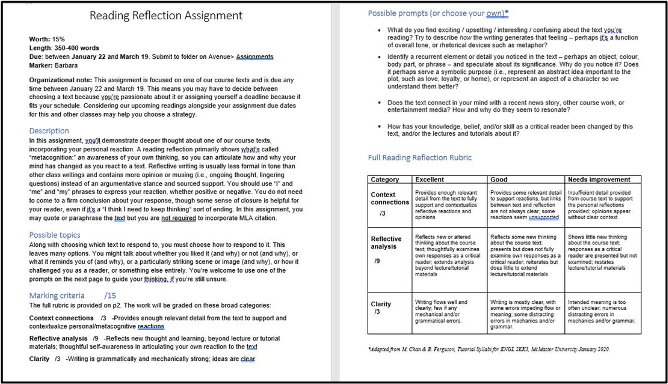8 Formatting assignment guidelines and rubrics
How did you develop, adapt, and/or format assignment guidelines or rubrics? What considerations did you bring to these documents, with students and/or TAs in mind?
BF: Although I sometimes used other professors’ assignment descriptions for inspiration about what to do (or not do), I also know from previous teaching that the best advice is to present the information as clearly and briefly as possible. I like to give choice in topics wherever I can, so the students can explore their own interests and the TAs aren’t reading 30 papers on the same text. The assignment has to match something in the course objectives, so that helps direct the type of work you need, and the description should also match whatever the grading details include — sometimes the holistic description of “A grade, B grade” in the ECS handbook isn’t especially relevant for the work you’re asking, so my advice is to be judicious about when you use it.

BF: For the document itself, I include a sort of at-a-glance summary list at the top left margin of the first page—usually with the due date, weight, length limits, document type, citation method—and then move to the shortest possible description of what this document does and, if necessary, how to go about it (i.e., sections required, resources for research, etc.).
Skip “the student will” nonsense — just give the description and instructions. I try not to take much more than a page, unless it’s a complex assignment. Talk it over with any TAs for feedback about gaps, clarity, etc., and to ensure they feel ready to answer questions and mark the thing, if that’s part of their job.
I also always include a sense of the marking expectations: whether these are a kind of checklist of elements worth specific points or a full rubric, include them here in the assignment description so students know what to focus on. For me, rubrics are always in a chart form that indicates what an A paper will demonstrate, such as a strong argumentative thesis statement, near-flawless MLA citation, etc., but it also gives detail about what will merit the least marks (no citation, no clear thesis). I believe they help the student know what to include, but also gives the grader items to highlight as obviously visible or not visible in the document, and that’s a huge help in any later grade queries. Rubrics are far from perfect but they can help students and TAs alike, and the reality is that the Ontario school system has been using them consistently in every subject for almost 20 years. Students who grew up in that system are very used to having this sort of guideline to look to, to understand their grade.

